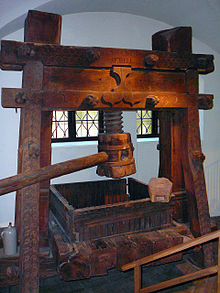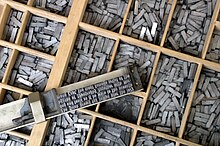Technological factors
See also: History of Western typography and Medieval technology
At the same time, a number of medieval products and technological processes had reached a level of maturity which allowed their potential use for printing purposes. Gutenberg took up these far-flung strands, combined them into one complete and functioning system, and perfected the printing process through all its stages by adding a number of inventions and innovations of his own:
Gutenberg adopted the basic design, thereby mechanizing the printing process.[17] Printing, however, put a demand on the machine quite different from pressing. Gutenberg adapted the construction so that the pressing power exerted by the platen on the paper was now applied both evenly and with the required sudden elasticity. To speed up the printing process, he introduced a movable undertable with a plane surface on which the sheets could be swiftly changed.[18]

Gutenberg greatly improved the process by treating typesetting and printing as two separate work steps. A goldsmith by profession, he created his type pieces from a lead-based alloy which suited printing purposes so well that it is still used today.[20] The mass production of metal letters was achieved by his key invention of a special hand mould, the matrix.[21] The Latin alphabet proved to be an enormous advantage in the process because, in contrast to logographic writing systems, it allowed the type-setter to represent any text with a theoretical minimum of only around two dozen different letters.[22]
Another factor conducive to printing arose from the book existing in the format of the codex, which had originated in the Roman period.[23] Considered the most important advance in the history of the book prior to printing itself, the codex had completely replaced the ancient scroll at the onset of the Middle Ages (500 AD).[24] The codex holds considerable practical advantages over the scroll format; it is more convenient to read (by turning pages), is more compact, less costly, and, in particular, unlike the scroll, both recto and verso could be used for writing − and printing.[25]

Despite this it appears that the final breakthrough of paper depended just as much on the rapid spread of movable-type printing.[30] It is notable that codices of parchment, which in terms of quality is superior to any other writing material,[31] still had a substantial share in Gutenberg's edition of the 42-line Bible.[32] After much experimentation, Gutenberg managed to overcome the difficulties which traditional water-based inks caused by soaking the paper, and found the formula for an oil-based ink suitable for high-quality printing with metal type.[33]
No comments:
Post a Comment